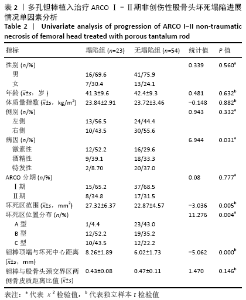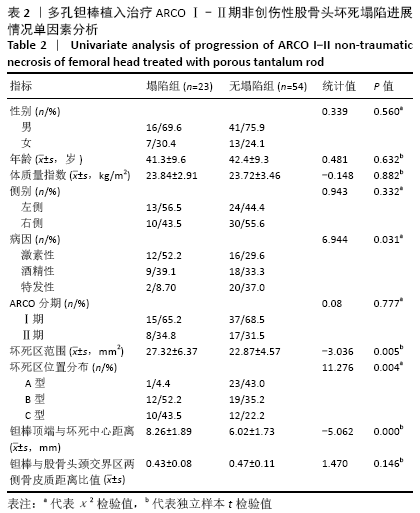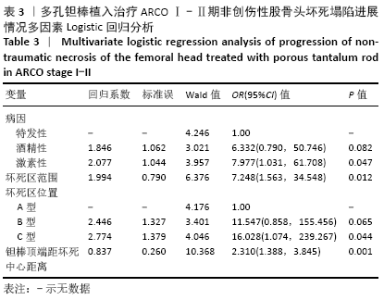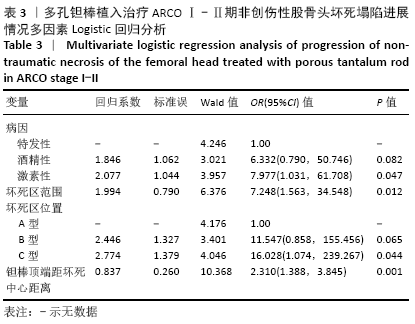[1] 罗锐,李国民,刘斌,等.三维“C”型臂X线定位多孔钽金属棒植入治疗ARCOⅠ-Ⅱ期非创伤性股骨头坏死[J].中华骨科杂志, 2019,39(23):1440-1446.
[2] 王春生,蒋武强,张栓平,等.无症状股骨头坏死病情进展及相关因素分析[J].中华外科杂志,2019,57(11):807-811.
[3] COHEN-ROSENBLUM A, CUI Q. Osteonecrosis of the femoral head. Orthop Clin North Am. 2019;50(2):139-149.
[4] HUANG W, GONG X, SANDIFORD S, et al. Outcome after a new porous tantalum rod implantation for treatment of early-stage femoral head osteonecrosis. Ann Transl Med. 2019;7(18):441.
[5] CHENG Q, TANG JL, GU JJ, et al. Total hip arthroplasty following failure of tantalum rod implantation for osteonecrosis of the femoral head with 5-to 10-year follow-up. BMC Musculoskelet Disord. 2018;19(1):289.
[6] YOON BH, MONT MA, KOO KH, et al. The 2019 revised version of association research circulation osseous staging system of osteonecrosis of the femoral head. J Arthroplasty. 2020;35(4):933-940.
[7] TAKASHIMA K, SAKAI T, HAMADA H, et al. Which classification system is most useful for classifying osteonecrosis of the femoral head? Clin Orthop Relat Res. 2018;476(6):1240-1249.
[8] SUGANO N, ATSUMI T, OHZONO K, et al. The 2001 revised criteria fordiagnosis,classification,and staging of idiopathic osteonecrosis of the femoral head. J Orthop Sci. 2002;7(5):601-605.
[9] 中国医师协会骨科医师分会显微修复工作委员会.成人股骨头坏死临床诊疗指南(2016)[J].中华骨科杂志,2016,36(15):945-954.
[10] PETEK D, HANNOUCHE D, SUVA D. Osteonecrosis of the femoral head: pathophysiology and current concepts of treatment. EFORT Open Rev. 2019;4(3):85-97.
[11] LIU Y, YAN L, ZHOU S, et al. Tantalum rod implantation for femoral head osteonecrosis:suevivorship analysis and determination of prognostic factors for total hip arthroplasty. Int Orthop. 2016;40(7):1397-1407.
[12] MORITA D, HASEGAWA Y, OKURA T, et al. Long-term outcomes of transtrochanteric rotational osteotomy for non-traumatic osteonecrosis of the femoral head. Bone Joint J. 2017;99-B(2):175-183.
[13] 何小强,廖军义,陈宇,等.国产多孔钽棒治疗早期股骨头缺血性坏死的临床疗效[J].中华创伤杂志,2017,33(6):521-526.
[14] AURÉGAN JC, VILLAIN B, BÉGUÉ T. What is the rate of patients undergoing a total hip arthroplasty after core decompression and insertion of a tantalum rod in osteonecrosis of the femoral head:a systematic review. Int Orthop. 2018;42(7):1631-1638.
[15] OLSEN M, LEWIS PM, MORRISON Z, et al. Total hip arthroplasty following failure of core decompresssion and tantalum rod implantation. Bone Joint J. 2016;98-B:1175-1179.
[16] 刘玮璐,张洋,张贤祚,等.多孔钽金属棒治疗股骨头坏死的最新研究进展[J].中华关节外科杂志(电子版),2017,11(2):176-179.
[17] TSAI SW, WU PK, CHEN CF, et al. Etiologies and outcome of osteonecrosis of the femoral head:etiology and outcome study in a Taiwan population. J Chin Med Assoc. 2016;79(1):39-45.
[18] 赵德伟.规范激素的临床应用,预防及早期治疗激素性股骨头坏死[J].中华骨科杂志,2019,39(23):1421-1423.
[19] 梁学振,刘光波,刘金豹,等.基于CT三维重建的激素性股骨头坏死患者股骨头坏死组织分布研究[J].中国修复重建外科杂志,2020, 34(1):57-62.
[20] 刘光波,梅玉倩,马海洋,等.股骨头坏死骨吸收区对股骨头内应力分布及疾病进展的影响[J].中华骨科杂志,2020,40(7):408-416.
[21] BAIG SA, BAIG MN. Osteonecrosis of the femoral head: etiology, investigations, and management. Cureus. 2018;10(8):e3171. |



